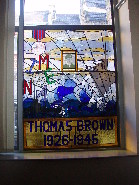Memorial Details
Memorial
Reference
Place
Map ref
Original Location
Which war
Dedication, Creation or Publication date
Memorial Description
There is a square stained glass window 8 feet high x 6 feet wide (2.43m x 1.82m) depicting a stylised sea scene. In the top left hand corner is a representation of the George Medal. In the centre is a black/white square-framed photo of Tommy Brown. The letters of the word “Enigma” are scattered on the left hand side. At the bottom are the words “Thomas Brown” and the dates “1926-1942” below, all in sans serif capitals.
On the sloping outside window ledge is a copper plate 8 inches high x 2 feet 6 inches wide (203mm x 762 mm) bearing the story of the award of the George Medal. The letters are in sans serif capitals throughout.
Materials used
Inscription
On outside plaque
On October 30th 1942, Thomas Brown,
a 16 year old Naafi Canteen Assistant serving on H.M.S Petard,
risked his life to help capture the Enigma codes from a sinking German U-boat.
His incredible bravery shortened World War II by at least 12 months
thus saving countless lives world wide.
This stain glass window was donated by the Naafi as a tribute to his bravery
Names
Who commissioned
How money was raised
Sculptor, Artist or Designer
Notes
2. Tommy Brown dived with two older men Lieutenant Francis Anthony Blair Fasson and Able Seaman Colin Grazier to rescue papers from the control room of the U-boat U-559. The two older men died drowned as the U-boat sank.
3. Copper engravings were presented at the ceremony to various bodies, inc. by the NAAFI at Guildford, who already possess the George Medal which was presented to them by the family.
4. Thomas was the youngest person ever to be awarded the George Cross, but he did not live to receive it. He was killed trying to rescue his sister Maureen from a fire at their home at South Shields when he was on leave from H.M.S. Belfast, his last ship.
5. Among those present was Geoff Richards, sonar operator from the original H.M.S. Petard, and John Gallehawk from Bletchley Park who helped break the Enigma codes.
6. At Bletchley Park is a room featuring the H.M.S. Petard story with a portrait of Thomas Brown.
7. The role of Tommy Brown was re-enacted at the British Military Tournament in December 2013 in London
Newspaper cuttings, photos or archival material
The Newcastle Journal 18/02/2002 reports unveiling; 01/05/2007 reports sale of mementoes from destroyer H.M.S. Petard; 23/10/2013 reports London Tournament display
Evening Chronicle 12/05/2000 reports proposal for a memorial.
Photo of the George Medal taken by Angela Conroy with acknowledgments to Tyne and Wear Archives and NAAFI.
External web link
Additional Research documents (click to download)
Research acknowledgements
Research In Progress
For their actions, Fasson and Grazier were posthumously awarded the George Cross. Being a civilian due to his NAAFI employment, Brown was awarded the George Medal. His mother Margaret and brother Stanley travelled to London to receive his medal on his behalf after Brown's death in 1945. Prior to being told about the presentation ceremony, his mother hadn't been told that Brown had received a medal for his actions. Unknown to Brown, the documents that he, Fasson, and Grazier retrieved were extremely valuable in breaking the German Enigma code. They allowed British codebreakers to attack the "Triton" key used by the U-boats, which had been invulnerable for nine months. Allied convoys in the Atlantic could be directed away from known U-boat locations. Winston Churchill wrote that the actions of the crew of Petard were crucial to the outcome of the war. Brown never knew the contents of those documents; information relating to Enigma was not released till decades after his death.
In 1985, his brothers Stan and David presented the NAAFI with Brown's medals, to be displayed at the Bletchley Park Museum of codebreaking in Buckinghamshire. In 1987, a stained glass window was dedicated to his memory in his home town at the Saville Exchange building. The museum has since closed, and Brown's medals are now on display at the NAAFI headquarters in Darlington. They were brought there to celebrate the 90th anniversary of the NAAFI in April 2010, with a ceremony being held to celebrate the return of Brown's medal to the North East. In attendance were five of his siblings, Lillian, Sylvia, Norman, Nancy, and Albert.


